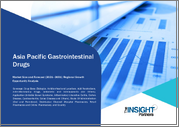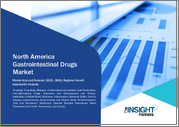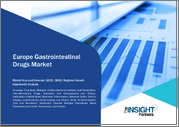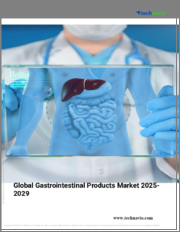
|
시장보고서
상품코드
1819725
아시아태평양의 위장약 시장 : 범위, 부문, 동향, 경쟁 분석(2021-2031년)Asia Pacific Gastrointestinal Drugs Market Report 2021-2031 by Scope, Segmentation, Dynamics, and Competitive Analysis |
||||||
아시아태평양의 위장약 시장은 크게 성장하고 2023년 121억 4,518만 달러, 2031년에는 약 223억 7,777만 달러에 이를 것으로 예측됩니다. 2023년부터 2031년까지 CAGR은 7.9%를 나타낼 전망입니다.
주요 요약 및 시장 분석
아시아태평양에는 중국, 일본, 인도, 호주, 한국 등 주요 국가가 포함됩니다. 중국과 인도의 인구가 많아지면서 이 지역의 제약회사의 관심이 높아지면서 시장 성장의 원동력이 되고 있습니다. 또한 위장병의 이환율 증가, 건강 관리 지출 증가, 의료 기술의 진보가 위장약 시장을 더욱 밀어 올리고 있습니다.
시장 세분화 분석
아시아태평양의 위장약 시장은 약물 등급별, 용도별, 투여 경로별, 유통 채널별로 구분할 수 있습니다.
1. 약물 등급 : 시장은 생물 제제, 방진제, 완하제, 산 중화제, 항염증제, 진토제 및 항구토제 등의 범주로 분류됩니다. 2023년에는 생물 제제가 가장 큰 시장 점유율을 차지했습니다.
2. 용도 : 시장은 용도별로 구분되며 과민성 장 증후군(IBS), 염증성 궤양성 대장염, 크론병, 위장염, 세리악병 등의 질환을 포함합니다. 2023년에는 IBS 부문이 가장 큰 점유율을 차지했습니다.
3. 투여 경로 : 시장은 경구와 비경구로 이분됩니다. 2023년에는 경구 부문이 시장을 독점했습니다.
4. 유통 채널 : 유통 채널에는 병원 약국, 소매 약국, 온라인 약국이 포함되어 있으며, 2023년에는 병원 약국이 가장 큰 시장 점유율을 차지합니다.
시장 전망
소화기 질환의 유병률은 세계적으로 상승 경향이 있으며, 새로운 치료법의 개발을 목표로 한 연구에 대한 자금 기여가 증가하고 있습니다. 예를 들어, 예일대학 의학부는 염증성 장질환(IBD)과 간질환을 포함한 다양한 소화기 질환을 연구하기 위해 국립 당뇨병 및 소화기·신장 질환 연구소(NIDDK)로부터 매년 800만 달러 이상을 지원 받고 있습니다. 마찬가지로 미국 노스캐롤라이나 대학 의과대학은 소화기 질환과 간 질환에 초점을 맞춘 연구에 연간 2,000만 달러 이상의 자금을 제공하고 있으며, 이러한 질병의 이해와 새로운 치료법 개발의 중요성을 강조하고 있습니다.
임상 연구의 최근 진보, 특히 인공지능(AI)의 통합은 소화기내과의 상황을 변화시키고 있습니다. AI는 대규모 데이터세트 분석에 점점 더 활용되고 보다 개별화된 효과적인 치료법의 선택으로 이어지고 있습니다. 머신러닝 알고리즘은 치료 반응의 예측 마커를 확인하고 개별 환자에 맞는 최적의 치료 전략을 가능하게 합니다.
AI는 또한 소화기 의료에서 이미징을 강화하고 있습니다. 딥러닝 알고리즘을 채택함으로써, 연구자는 CT 스캔이나 내시경 화상 등의 의료 화상을 고정밀도로 해석할 수 있게 되어, 소화관 이상의 조기 발견이 용이하게 됩니다. 예를 들어, 인공지능은 대장 내시경 검사 중 대장 폴립의 진단에 유망하며 불필요한 수술 개입을 줄일 수 있습니다. 뉴캐슬 영구 챠리타블 재단과 같은 조직의 자금 지원을 통해 연구자들은 장내 세균총과 장관 줄기세포에 초점을 맞추고 IBD와 궤양성 대장염의 새로운 치료법 개발에 AI의 응용을 모색하고 있습니다.
신약 개발을 위한 연구 투자와 AI를 활용한 수법에 대한 투자가 증가함에 따라 소화기 질환에 대한 혁신적인 치료 솔루션이 도입되어 위장약 시장의 향후 동향이 형성될 것으로 예측됩니다.
각국의 통찰
아시아태평양 위장약 시장은 여러 나라의 큰 기여를 특징으로 하며 2023년에는 중국이 시장을 선도합니다. 중국의 성장은 인구 많음, 소화기 질환 유병률 증가, 의약품 판매 증가, 지지적인 규제 틀에 기인합니다.
중국은 헬스케어 인프라를 적극적으로 강화하고 다양한 의약품을 개발하고 있습니다. 최근 조사에 따르면 중국에서 과민성 장 증후군(IBS)의 유병률은 3.2%에서 17.7%로, 이 나라에서 소화기 질환의 부담의 크기를 부조하고 있습니다. 이에 따라 중국 정부는 평균 수명 개선과 헬스케어 자원의 배분을 목표로, 이러한 질환의 발생을 감시 및 관리하기 위해 중국 위장 건강 지수(GHI)와 같은 이니셔티브를 실시했습니다.
중국에는 국내외 제약기업이 진출하고 있으며 시장 성장을 가속하고 있습니다. 예를 들어, 2023년 9월, EA 파마 주식회사와 TransThera Sciences, Inc.는 소화기계의 염증성 질환을 표적으로 하는 첨단 치료제를 개발하기 위한 전략적 제휴를 발표하여 이 분야에서 혁신에 대한 헌신을 제시했습니다.
기업 프로파일
아시아태평양의 위장약 시장의 주요 기업으로는 Sanofi SA, GSK Plc, Johnson & Johnson, Bausch Health Companies Inc, AstraZeneca Plc, Takeda Pharmaceutical, AbbVie Inc, Bayer AG, Pfizer Inc 등이 있습니다. 이러한 기업들은 시장에서의 존재감을 높이고 소비자에게 혁신적인 솔루션을 제공하기 위해 사업 확대, 제품 혁신, M&A 등 다양한 전략을 추구하고 있습니다.
목차
제1장 서론
제2장 주요 요약
- 주요 인사이트
제3장 조사 방법
- 2차 조사
- 1차 조사
- 가설의 책정
- 거시경제 요인분석
- 기초 수치의 개발
- 데이터의 삼각측량
- 국가 레벨 데이터
제4장 아시아태평양의 위장약 시장 : 주요 시장 역학
- 시장 성장 촉진요인
- 소화기 질환 환자 증가
- 생물 제제 개발 증가
- 시장 성장 억제요인
- 생물학적 제제 고비용
- 중증 궤양성 대장염 또는 크론병에 대한 생물학적 제형 평균 비용
- 시장 기회
- 기업에 의한 전략적 이니셔티브
- 향후의 동향
- 신약 개발과 인공지능 기반 기술을 위한 연구투자 증가
- 성장 촉진요인과 억제요인의 영향
제5장 위장약 시장 - 아시아태평양 분석
- 아시아태평양의 위장약 시장 수익, 2021년-2031년
제6장 아시아태평양의 위장약 시장 분석 : 약제 등급별
- 생물제제
- 지사약 및 완하제
- 산 중화제
- 항염증제
- 진토제 및 항구토제
- 기타
제7장 아시아태평양의 위장약 시장 분석 : 용도별
- 과민성 장 증후군
- 염증성 궤양성 대장염
- 크론병
- 위장염
- 세리악병
- 기타
제8장 아시아태평양의 위장약 시장 분석 : 투여 경로별
- 경구
- 비경구
제9장 아시아태평양의 위장약 시장 분석 : 유통 경로별
- 병원 약국
- 소매 약국
- 온라인 약국
제10장 아시아태평양의 위장약 시장 : 국가별 분석
- 아시아태평양
- 중국
- 일본
- 인도
- 호주
- 한국
- 아시아태평양의 기타 국가
제11장 업계 정세
- 아시아태평양의 위장약 시장의 성장 전략
- 유기적 성장 전략
- 무기적 성장 전략
제12장 기업 프로파일
- Sanofi SA
- GSK Plc
- Johnson & Johnson
- Bausch Health Companies Inc
- AstraZeneca Plc
- Takeda Pharmaceutical Co Ltd
- AbbVie Inc
- Bayer AG
- Celltrion Inc
- Pfizer Inc
제13장 부록
SHW 25.10.01The Asia Pacific gastrointestinal drugs market is projected to grow significantly, reaching an estimated US$ 22,377.77 million by 2031, up from US$ 12,145.18 million in 2023. This growth represents a compound annual growth rate (CAGR) of 7.9% from 2023 to 2031.
Executive Summary and Market Analysis
The Asia Pacific region encompasses several key countries, including China, Japan, India, Australia, South Korea, and others. The substantial populations in China and India, along with the increasing interest from pharmaceutical companies in this region, are driving market growth. Additionally, the rising incidence of gastrointestinal disorders, increased healthcare expenditure, and advancements in medical technology are further propelling the gastrointestinal drugs market.
Market Segmentation Analysis
The gastrointestinal drugs market in Asia Pacific can be segmented based on drug class, application, route of administration, and distribution channel:
1. Drug Class: The market is divided into several categories, including biologics, antidiarrheal and laxatives, acid neutralizers, anti-inflammatory drugs, antiemetic and antinauseants, among others. In 2023, biologics accounted for the largest market share.
2. Application: The market is also segmented by application, which includes conditions such as irritable bowel syndrome (IBS), inflammatory ulcerative colitis, Crohn's disease, gastroenteritis, celiac disease, and others. The IBS segment held the largest share in 2023.
3. Route of Administration: The market is bifurcated into oral and parenteral routes. The oral administration segment dominated the market in 2023.
4. Distribution Channel: The distribution channels include hospital pharmacies, retail pharmacies, and online pharmacies, with hospital pharmacies holding the largest market share in 2023.
Market Outlook
The prevalence of gastrointestinal diseases is on the rise globally, prompting increased funding for research aimed at developing new treatment methods. For example, the Yale School of Medicine receives over US$ 8 million annually from the National Institute of Diabetes and Digestive and Kidney Diseases (NIDDK) to explore various gastrointestinal disorders, including inflammatory bowel disease (IBD) and liver diseases. Similarly, the UNC School of Medicine has over US$ 20 million in annual funding for research focused on gastrointestinal and liver diseases, emphasizing the importance of understanding these conditions and developing new therapies.
Recent advancements in clinical research, particularly the integration of artificial intelligence (AI), are transforming the landscape of gastrointestinal medicine. AI is increasingly utilized to analyze large datasets, leading to more personalized and effective treatment options. Machine learning algorithms can identify predictive markers for treatment responses, allowing for optimized therapeutic strategies tailored to individual patients.
AI is also enhancing diagnostic imaging in gastrointestinal medicine. By employing deep learning algorithms, researchers can analyze medical images, such as CT scans and endoscopic images, with high precision, facilitating early detection of gastrointestinal abnormalities. For instance, AI has shown promise in diagnosing colorectal polyps during colonoscopy, potentially reducing unnecessary surgical interventions. With funding from organizations like the Newcastle Permanent Charitable Foundation, researchers are exploring AI applications in developing new therapies for IBD and ulcerative colitis, focusing on the gut microbiome and intestinal stem cells.
The increasing investment in research for novel drug development and AI-based methodologies is expected to introduce innovative treatment solutions for gastrointestinal conditions, shaping future trends in the gastrointestinal drugs market.
Country Insights
The Asia Pacific gastrointestinal drugs market is characterized by significant contributions from various countries, with China leading the market in 2023. The growth in China can be attributed to its large population, the rising prevalence of gastrointestinal diseases, increasing pharmaceutical sales, and supportive regulatory frameworks.
China is actively enhancing its healthcare infrastructure and developing various medicinal products. A recent study indicated that the prevalence of irritable bowel syndrome (IBS) in China ranges from 3.2% to 17.7%, highlighting the substantial burden of gastrointestinal diseases in the country. In response, the Chinese government has implemented initiatives like the China Gastrointestinal Health Index (GHI) to monitor and control the incidence of these diseases, aiming to improve life expectancy and healthcare resource distribution.
The presence of both local and international pharmaceutical companies in China is fostering market growth. For instance, in September 2023, EA Pharma Co., Ltd. and TransThera Sciences, Inc. announced a strategic collaboration to develop advanced therapeutics targeting inflammatory diseases of the gastrointestinal system, showcasing the commitment to innovation in this sector.
Company Profiles
Key players in the Asia Pacific gastrointestinal drugs market include Sanofi SA, GSK Plc, Johnson & Johnson, Bausch Health Companies Inc, AstraZeneca Plc, Takeda Pharmaceutical Co Ltd, AbbVie Inc, Bayer AG, and Pfizer Inc. These companies are pursuing various strategies, including expansion, product innovation, and mergers and acquisitions, to enhance their market presence and deliver innovative solutions to consumers.
Table Of Contents
1. Introduction
- 1.1 The Insight Partners Research Report Guidance
- 1.2 Market Segmentation
2. Executive Summary
- 2.1 Key Insights
3. Research Methodology
- 3.1 Secondary Research
- 3.2 Primary Research
- 3.2.1 Hypothesis formulation:
- 3.2.2 Macro-economic factor analysis:
- 3.2.3 Developing base number:
- 3.2.4 Data Triangulation:
- 3.2.5 Country level data:
4. Asia Pacific Gastrointestinal Drugs Market - Key Market Dynamics
- 4.1 Market Drivers
- 4.1.1 Rising Cases of Gastrointestinal Diseases
- 4.1.2 Increasing Development of Biologics
- 4.2 Market Restraints
- 4.2.1 High Cost of Biologics
- 4.2.2 Average Cost of Biologic Drugs for Severe Ulcerative Colitis or Crohn's Disease
- 4.3 Market Opportunities
- 4.3.1 Strategic Initiatives by Companies
- 4.4 Future Trends
- 4.4.1 Increasing Research Investment for Novel Drug Development and Artificial Intelligence-Based Techniques
- 4.5 Impact of Drivers and Restraints:
5. Gastrointestinal Drugs Market - Asia Pacific Analysis
- 5.1 Asia Pacific Gastrointestinal Drugs Market Revenue (US$ Million), 2021-2031
6. Asia Pacific Gastrointestinal Drugs Market Analysis - by Drug Class
- 6.1 Biologics
- 6.1.1 Overview
- 6.1.2 Biologics: Asia Pacific Gastrointestinal Drugs Market - Revenue and Forecast to 2031 (US$ Million)
- 6.2 Antidiarrheal and Laxatives
- 6.2.1 Overview
- 6.2.2 Antidiarrheal and Laxatives: Asia Pacific Gastrointestinal Drugs Market - Revenue and Forecast to 2031 (US$ Million)
- 6.3 Acid Neutralizers
- 6.3.1 Overview
- 6.3.2 Acid Neutralizers: Asia Pacific Gastrointestinal Drugs Market - Revenue and Forecast to 2031 (US$ Million)
- 6.4 Anti-inflammatory Drugs
- 6.4.1 Overview
- 6.4.2 Anti-inflammatory Drugs: Asia Pacific Gastrointestinal Drugs Market - Revenue and Forecast to 2031 (US$ Million)
- 6.5 Antiemetic and Antinauseants
- 6.5.1 Overview
- 6.5.2 Antiemetic and Antinauseants: Asia Pacific Gastrointestinal Drugs Market - Revenue and Forecast to 2031 (US$ Million)
- 6.6 Others
- 6.6.1 Overview
- 6.6.2 Others: Asia Pacific Gastrointestinal Drugs Market - Revenue and Forecast to 2031 (US$ Million)
7. Asia Pacific Gastrointestinal Drugs Market Analysis - by Application
- 7.1 Irritable Bowel Syndrome
- 7.1.1 Overview
- 7.1.2 Irritable Bowel Syndrome: Asia Pacific Gastrointestinal Drugs Market - Revenue and Forecast to 2031 (US$ Million)
- 7.2 Inflammatory Ulcerative Colitis
- 7.2.1 Overview
- 7.2.2 Inflammatory Ulcerative Colitis: Asia Pacific Gastrointestinal Drugs Market - Revenue and Forecast to 2031 (US$ Million)
- 7.3 Crohn's Disease
- 7.3.1 Overview
- 7.3.2 Crohn's Disease: Asia Pacific Gastrointestinal Drugs Market - Revenue and Forecast to 2031 (US$ Million)
- 7.4 Gastroenteritis
- 7.4.1 Overview
- 7.4.2 Gastroenteritis: Asia Pacific Gastrointestinal Drugs Market - Revenue and Forecast to 2031 (US$ Million)
- 7.5 Celiac Disease
- 7.5.1 Overview
- 7.5.2 Celiac Disease: Asia Pacific Gastrointestinal Drugs Market - Revenue and Forecast to 2031 (US$ Million)
- 7.6 Others
- 7.6.1 Overview
- 7.6.2 Others: Asia Pacific Gastrointestinal Drugs Market - Revenue and Forecast to 2031 (US$ Million)
8. Asia Pacific Gastrointestinal Drugs Market Analysis - by Route of Administration
- 8.1 Oral
- 8.1.1 Overview
- 8.1.2 Oral: Asia Pacific Gastrointestinal Drugs Market - Revenue and Forecast to 2031 (US$ Million)
- 8.2 Parenteral
- 8.2.1 Overview
- 8.2.2 Parenteral: Asia Pacific Gastrointestinal Drugs Market - Revenue and Forecast to 2031 (US$ Million)
9. Asia Pacific Gastrointestinal Drugs Market Analysis - by Distribution Channel
- 9.1 Hospital Pharmacies
- 9.1.1 Overview
- 9.1.2 Hospital Pharmacies: Asia Pacific Gastrointestinal Drugs Market - Revenue and Forecast to 2031 (US$ Million)
- 9.2 Retail Pharmacies
- 9.2.1 Overview
- 9.2.2 Retail Pharmacies: Asia Pacific Gastrointestinal Drugs Market - Revenue and Forecast to 2031 (US$ Million)
- 9.3 Online Pharmacies
- 9.3.1 Overview
- 9.3.2 Online Pharmacies: Asia Pacific Gastrointestinal Drugs Market - Revenue and Forecast to 2031 (US$ Million)
10. Asia Pacific Gastrointestinal Drugs Market - Country Analysis
- 10.1 Asia Pacific
- 10.1.1 Asia Pacific Gastrointestinal Drugs Market - Revenue and Forecast Analysis - by Country
- 10.1.1.1 China: Asia Pacific Gastrointestinal Drugs Market - Revenue and Forecast to 2031 (US$ Million)
- 10.1.1.1.1 China: Asia Pacific Gastrointestinal Drugs Market Breakdown, by Drug Class
- 10.1.1.1.2 China: Asia Pacific Gastrointestinal Drugs Market Breakdown, by Application
- 10.1.1.1.3 China: Asia Pacific Gastrointestinal Drugs Market Breakdown, by Route Of Administration
- 10.1.1.1.4 China: Asia Pacific Gastrointestinal Drugs Market Breakdown, by Distribution Channel
- 10.1.1.2 Japan: Asia Pacific Gastrointestinal Drugs Market - Revenue and Forecast to 2031 (US$ Million)
- 10.1.1.2.1 Japan: Asia Pacific Gastrointestinal Drugs Market Breakdown, by Drug Class
- 10.1.1.2.2 Japan: Asia Pacific Gastrointestinal Drugs Market Breakdown, by Application
- 10.1.1.2.3 Japan: Asia Pacific Gastrointestinal Drugs Market Breakdown, by Route Of Administration
- 10.1.1.2.4 Japan: Asia Pacific Gastrointestinal Drugs Market Breakdown, by Distribution Channel
- 10.1.1.3 India: Asia Pacific Gastrointestinal Drugs Market - Revenue and Forecast to 2031 (US$ Million)
- 10.1.1.3.1 India: Asia Pacific Gastrointestinal Drugs Market Breakdown, by Drug Class
- 10.1.1.3.2 India: Asia Pacific Gastrointestinal Drugs Market Breakdown, by Application
- 10.1.1.3.3 India: Asia Pacific Gastrointestinal Drugs Market Breakdown, by Route Of Administration
- 10.1.1.3.4 India: Asia Pacific Gastrointestinal Drugs Market Breakdown, by Distribution Channel
- 10.1.1.4 Australia: Asia Pacific Gastrointestinal Drugs Market - Revenue and Forecast to 2031 (US$ Million)
- 10.1.1.4.1 Australia: Asia Pacific Gastrointestinal Drugs Market Breakdown, by Drug Class
- 10.1.1.4.2 Australia: Asia Pacific Gastrointestinal Drugs Market Breakdown, by Application
- 10.1.1.4.3 Australia: Asia Pacific Gastrointestinal Drugs Market Breakdown, by Route Of Administration
- 10.1.1.4.4 Australia: Asia Pacific Gastrointestinal Drugs Market Breakdown, by Distribution Channel
- 10.1.1.5 South Korea: Asia Pacific Gastrointestinal Drugs Market - Revenue and Forecast to 2031 (US$ Million)
- 10.1.1.5.1 South Korea: Asia Pacific Gastrointestinal Drugs Market Breakdown, by Drug Class
- 10.1.1.5.2 South Korea: Asia Pacific Gastrointestinal Drugs Market Breakdown, by Application
- 10.1.1.5.3 South Korea: Asia Pacific Gastrointestinal Drugs Market Breakdown, by Route Of Administration
- 10.1.1.5.4 South Korea: Asia Pacific Gastrointestinal Drugs Market Breakdown, by Distribution Channel
- 10.1.1.6 Rest of APAC: Asia Pacific Gastrointestinal Drugs Market - Revenue and Forecast to 2031 (US$ Million)
- 10.1.1.6.1 Rest of APAC: Asia Pacific Gastrointestinal Drugs Market Breakdown, by Drug Class
- 10.1.1.6.2 Rest of APAC: Asia Pacific Gastrointestinal Drugs Market Breakdown, by Application
- 10.1.1.6.3 Rest of APAC: Asia Pacific Gastrointestinal Drugs Market Breakdown, by Route Of Administration
- 10.1.1.6.4 Rest of APAC: Asia Pacific Gastrointestinal Drugs Market Breakdown, by Distribution Channel
- 10.1.1.1 China: Asia Pacific Gastrointestinal Drugs Market - Revenue and Forecast to 2031 (US$ Million)
- 10.1.1 Asia Pacific Gastrointestinal Drugs Market - Revenue and Forecast Analysis - by Country
11. Industry Landscape
- 11.1 Overview
- 11.2 Growth Strategies in Asia Pacific Gastrointestinal Drugs Market
- 11.3 Organic Growth Strategies
- 11.3.1 Overview
- 11.4 Inorganic Growth Strategies
- 11.4.1 Overview
12. Company Profiles
- 12.1 Sanofi SA
- 12.1.1 Key Facts
- 12.1.2 Business Description
- 12.1.3 Products and Services
- 12.1.4 Financial Overview
- 12.1.5 SWOT Analysis
- 12.1.6 Key Developments
- 12.2 GSK Plc
- 12.2.1 Key Facts
- 12.2.2 Business Description
- 12.2.3 Products and Services
- 12.2.4 Financial Overview
- 12.2.5 SWOT Analysis
- 12.2.6 Key Developments
- 12.3 Johnson & Johnson
- 12.3.1 Key Facts
- 12.3.2 Business Description
- 12.3.3 Products and Services
- 12.3.4 Financial Overview
- 12.3.5 SWOT Analysis
- 12.3.6 Key Developments
- 12.4 Bausch Health Companies Inc
- 12.4.1 Key Facts
- 12.4.2 Business Description
- 12.4.3 Products and Services
- 12.4.4 Financial Overview
- 12.4.5 SWOT Analysis
- 12.4.6 Key Developments
- 12.5 AstraZeneca Plc
- 12.5.1 Key Facts
- 12.5.2 Business Description
- 12.5.3 Products and Services
- 12.5.4 Financial Overview
- 12.5.5 SWOT Analysis
- 12.5.6 Key Developments
- 12.6 Takeda Pharmaceutical Co Ltd
- 12.6.1 Key Facts
- 12.6.2 Business Description
- 12.6.3 Products and Services
- 12.6.4 Financial Overview
- 12.6.5 SWOT Analysis
- 12.6.6 Key Developments
- 12.7 AbbVie Inc
- 12.7.1 Key Facts
- 12.7.2 Business Description
- 12.7.3 Products and Services
- 12.7.4 Financial Overview
- 12.7.5 SWOT Analysis
- 12.7.6 Key Developments
- 12.8 Bayer AG
- 12.8.1 Key Facts
- 12.8.2 Business Description
- 12.8.3 Products and Services
- 12.8.4 Financial Overview
- 12.8.5 SWOT Analysis
- 12.8.6 Key Developments
- 12.9 Celltrion Inc
- 12.9.1 Key Facts
- 12.9.2 Business Description
- 12.9.3 Products and Services
- 12.9.4 Financial Overview
- 12.9.5 SWOT Analysis
- 12.9.6 Key Developments
- 12.10 Pfizer Inc
- 12.10.1 Key Facts
- 12.10.2 Business Description
- 12.10.3 Products and Services
- 12.10.4 Financial Overview
- 12.10.5 SWOT Analysis
- 12.10.6 Key Developments
13. Appendix
- 13.1 About The Insight Partners
- 13.2 Glossary of Terms



















